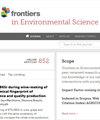环境类型分析有助于更好地了解雨水灌溉生产系统成功的根本原因和局限性
IF 3.3
3区 环境科学与生态学
Q2 ENVIRONMENTAL SCIENCES
引用次数: 0
摘要
目前对印度西孟加拉邦班库拉地区进行的农学诊断研究,通过对多个生产系统组成部分进行社会生态分析,研究了作物产量的变化。研究采用了环境类型分析法进行根本原因分析,以深入研究影响雨水灌溉生产系统性能的变量。地球母亲、人类、机器、管理和材料(5Ms 概念)是变量分组的五个指标。研究结果表明,该地区地形起伏不定,降雨模式难以预测,干旱频发,因此土壤十分脆弱。土地利用、土地利用变化和植被指数(LULC)的归一化差异植被指数(NDVI)显示,在希尔班德(Hirbandh)和拉尼班德(Ranibandh)区块,农业面积分别占总面积的 60% 和 43%。土壤呈酸性,缺乏宏量和微量营养元素(磷、硫和硼),持水能力差(50 厘米土壤深度为 35 至 55 毫米)。沙子和土壤中的有机碳含量分别在 43.04%-82.32% 和 0.17%-1.01% 之间,细菌数量较少。这些因素是造成耕作强度低(106%)和水稻产量低(每公顷 3,021 公斤)的根本原因。总之,这项研究有助于设计和推广可持续景观管理方法,从而确保在证据有限的类似农业生态环境中提高种植密度和系统生产力。本文章由计算机程序翻译,如有差异,请以英文原文为准。
Envirotyping helps in better understanding the root cause of success and limitations of rainfed production systems
The current diagnostic agronomy study of the Bankura region of West Bengal, India, examined the variations in crop yields through a socio-ecological analysis of multiple production system components. Envirotyping for root cause analysis was employed to delve into the variables that affect the performance of rainfed production systems. Mother Earth, man, machine, management, and materials (5Ms concept) were the five indicators under which the variables were grouped. Findings demonstrated the fragility of the region’s soils due to its undulating terrain, unpredictable rainfall patterns, and frequent drought scenarios. The LULC’s NDVI showed that the agricultural area is about 60% and 43% of the total geographical area in the Hirbandh and Ranibandh blocks, respectively. Soils are acidic and diagnosed with deficiency of both macro and micronutrients (phosphorous, sulfur, and boron) having poor water holding capacity (35 to 55 mm for a 50 cm soil depth). The sand and soil organic carbon contents ranged between 43.04%–82.32% and 0.17%–1.01%, respectively with a low bacterial population. These factors are the root cause for low cropping intensity (106%) and low paddy productivity (3,021 kg/ha). Overall, the study contributes to designing and scaling-up of sustainable landscape management practices that could ensure higher cropping intensity and system productivity in similar agro-ecologies with limited evidence.
求助全文
通过发布文献求助,成功后即可免费获取论文全文。
去求助
来源期刊

Frontiers in Environmental Science
Environmental Science-General Environmental Science
CiteScore
4.50
自引率
8.70%
发文量
2276
审稿时长
12 weeks
期刊介绍:
Our natural world is experiencing a state of rapid change unprecedented in the presence of humans. The changes affect virtually all physical, chemical and biological systems on Earth. The interaction of these systems leads to tipping points, feedbacks and amplification of effects. In virtually all cases, the causes of environmental change can be traced to human activity through either direct interventions as a consequence of pollution, or through global warming from greenhouse case emissions. Well-formulated and internationally-relevant policies to mitigate the change, or adapt to the consequences, that will ensure our ability to thrive in the coming decades are badly needed. Without proper understanding of the processes involved, and deep understanding of the likely impacts of bad decisions or inaction, the security of food, water and energy is a risk. Left unchecked shortages of these basic commodities will lead to migration, global geopolitical tension and conflict. This represents the major challenge of our time. We are the first generation to appreciate the problem and we will be judged in future by our ability to determine and take the action necessary. Appropriate knowledge of the condition of our natural world, appreciation of the changes occurring, and predictions of how the future will develop are requisite to the definition and implementation of solutions.
Frontiers in Environmental Science publishes research at the cutting edge of knowledge of our natural world and its various intersections with society. It bridges between the identification and measurement of change, comprehension of the processes responsible, and the measures needed to reduce their impact. Its aim is to assist the formulation of policies, by offering sound scientific evidence on environmental science, that will lead to a more inhabitable and sustainable world for the generations to come.
 求助内容:
求助内容: 应助结果提醒方式:
应助结果提醒方式:


